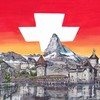HOME | DD
 LePtitSuisse1912 — Chateau d'Yvoire avec les Alpes
LePtitSuisse1912 — Chateau d'Yvoire avec les Alpes

#alpes #alps #frenchalps #alpesfrançaises #architecture #bateau #boats #castello #castle #chateau #churcharchitecture #europa #europe #europeanhistory #exterior #exteriorarchitecture #france #frenchhistory #histoire #lac #lacleman #lake #lakegeneva #medieval #medievalarchitecture #medievalcity #medievaltown #oldarchitecture #savoie #schloss #ship #yvoire #architectureexterior #architecturephotography #hautesavoie #reflectionwater #exteriorphotography #medievalcastle #alpsmountains #reflectionslake #histoiredefrance #histoirefrançaise
Published: 2020-04-18 12:53:27 +0000 UTC; Views: 1942; Favourites: 197; Downloads: 0
Redirect to original
Description
Yvoire est une petite cité médiévale située au bord du lac Léman entre Genève et Thonon-les-Bains dans le département de Haute-Savoie en France.
Cette place forte de position stratégique fût au centre des guerres qui opposèrent les comtes de Savoie aux seigneurs de Faucigny qui étaient alliés aux comtes de Genève. En 1306 Amédée V comte de Savoie acquière les droits sur le château et le village et c’est lui qui fera fortifier le bourg que l’on peut admirer de nos jours.
Le château
Au 10ème siècle un donjon fortifié avec un pont-levis se dressait au bout de la pointe d’Yvoire. Ce premier château appartenait à la famille de Compey. Anselme de Compey avait fait allégeance à Béatrice de Faucigny et malgré cela après sa mort ses enfant cédèrent les droits du bourg et du château au comte de Savoie Amédée V d’après un acte notarié datant de 29 aout 1306. Depuis cette date Yvoire passa du statut de petite seigneurie à celui de place forte. Amédée V fit fortifier le château et tout le village par prudence. Les travaux de fortification de château actuel durèrent de 1308 à 1314. L’ancien donjon fortifié des Compey ne résista pas l’usure du temps, non entretenu il finit par s’écrouler en 1324. Malgré tous ces travaux, la garnison du château resta peu nombreuse et ne comprenait pas plus d’une vingtaine d’hommes. Durant les guerres de religion du 16ème siècle, des français, des Genevois et des Bernois ennemis du duc de Savoie prirent possession du château et le brûlèrent.
Du château d’Yvoire, il ne subsista plus que les murs. Plus tard les ruines du donjon fûrent réaménagées pour redevenir habitables, malgré cela le château resta pendant plus de 350 ans sans toiture, un simple cube posé sur la pointe d’Yvoire. En 1665 la seigneurie d’Yvoire fût achetée par la famille Bouvier qui la possède encore de nos jours. La seigneurie d’Yvoire devint une baronnie en 1772.
Entre 1919 et 1939, le baron Felix d’Yvoire entreprit d’importants travaux de restauration à la suite desquels un toit ornait de nouveau le château.
L’église
L’église d’Yvoire est sans doute l’élément le plus emblématique de La ville. Elle est dédiée au martyr Romain Saint-Pancrace. L’église à passablement été agrandie et modifiée aux cours des siècles ce qui explique son manque d’homogénéité au niveau de son style architecturale. Les parties les plus anciennes du bâtiment datent du 14ème siècle soit de l’époque de la fortification du bourg par Amédée V. Autrefois l’église était dotée d’un clocher-mur. Soit un mur d’environ un mètre d’épaisseur percé d’ouvertures où l’on plaçait les cloches. Ce clocher-mur fût détruit en 1854 lors de la construction du clocher à bulbe construit entre 1854 et 1856. Ce type de clocher est typique de l’architecture religieuse piémontais de la fin du 19ème siècle. En 1989 les écailles de fer du bulbe qui avaient fini par rouiller furent remplacés par de l’acier inoxydable.
Les Remparts
Des remparts en demi-cercle allant d’une berge à l’autre du Léman protégeaient la ville des attaques durant le moyen âge. Des créneaux ornaient ces remparts jusqu’à l’occupation bernoise de la place forte de 1536 à 1591 où ils furent démontés à l’exception de quelques-uns à proximité de la porte de Nernier. Deux portes régulaient les entrées et sorties de la ville, celle de Nernier et de Rovorée.
A l’époque tous les soirs les portes étaient fermées et les herses baissées. Les deux portes de la ville étaient surmontées d’une tour dont celle de Nernier est encore bien conservée. Celle de Rovorée était en trop mauvais état et fût démolie en 1875.
Source des informations : Le livre : Cahier du patrimoine « Yvoire » Au éditions de l’astronome
Yvoire
Yvoire is a small medieval town located on the shores of Lake Geneva between Geneva and Thonon-les-Bains in the department of Haute-Savoie in France.
This stronghold of strategic position was at the center of the wars between the counts of Savoy and the lords of Faucigny who were allied with the counts of Geneva. In 1306 Amadeus V count of Savoy acquires the rights on the castle and the village and it is him which will make fortify the borough which one can admire nowadays.
The castle
In the 10th century a fortified keep with a drawbridge stood at the end of the tip of Yvoire. This first castle belonged to the Compey family. Anselme de Compey had made allegiance to Beatrice de Faucigny and despite this after his death, his children ceded the rights of the town and the castle to the Count of Savoy Amadeus V according to a notarial act dating from August 29, 1306. From that date Yvoire passed from the statute of small lordship to that of stronghold. Amadeus V made fortify the castle and all the village by prudence. The fortification works of the current castle lasted from 1308 to 1314. The old fortified keep of the Compey family didn't resist to the wear of time, not maintained it ended up collapsing in 1324. Despite all these works, the garrison of the castle remained small and didn't include more than twenty men. During the wars of religion of the 16th century, French, Genevese and Bernese enemies of the Duke of Savoy took possession of the castle and burned it.
Only the walls remained of the Yvoire castle. Later the ruin of the keep was refurbished to become habitable again, despite this the castle remained for more than 350 years without roof, a simple cube placed on the tip of Yvoire. In 1665 the lordship of Yvoire was bought by the Bouvier family who still own it today. The lordship of Yvoire became a barony in 1772.
Between 1919 and 1939, Baron Felix d’Yvoire undertook major restoration work, following which a new roof once again adorned the castle.
The church
The Church of Yvoire is undoubtedly the most emblematic element of the town. Its dedicated to the Roman martyr St-Pancras. The church has been considerably enlarged and modified over the centuries, which explains its lack of homogeneity in terms of its architectural style. The oldest parts of the building date from the 14th century, that is to say from the time of the fortification of the town by Amadeus V. In the past, the church had a Bell-gable. Or a wall about a meter thick pierced with openings where the bells were placed. This Bell-gable was destroyed in 1854 during the construction of the onion dome built between 1854 and 1856. This type of bell tower is typical of Piedmontese religious architecture at the end of the 19th century. In 1989 the iron scales of the onion dome which had finally rusted were replaced by stainless steel.
The curtain walls
The curtain walls in a semicircle going from one bank to the other of Lake Geneva protected the town from attacks during the Middle Ages. Battlements adorned these curtain walls until the Bernese occupation of the city from 1536 to 1591 where they were dismantled with the exception of a few near the gate of Nernier. Two gates regulated the entrances and exits of the town, that of Nernier and Rovorée.
At the time every night the doors were closed and the portcullises lowered. The two gates of the town were surmounted by a tower of which that of Nernier is still well preserved. That of Rovorée was in too bad condition and was demolished in 1875.
Source of information: The book: Cahier du patrimoine "Yvoire" In the Editions de l'Astronome
Related content
Comments: 29

👍: 0 ⏩: 1

👍: 0 ⏩: 1

👍: 1 ⏩: 1

👍: 0 ⏩: 1

👍: 1 ⏩: 0

Thank you so much
👍: 1 ⏩: 0

so in this town it may be possible, but the castle is unfortunately private property
👍: 0 ⏩: 0

Merci beaucoup 
👍: 1 ⏩: 0

Thank you so much
👍: 1 ⏩: 1































